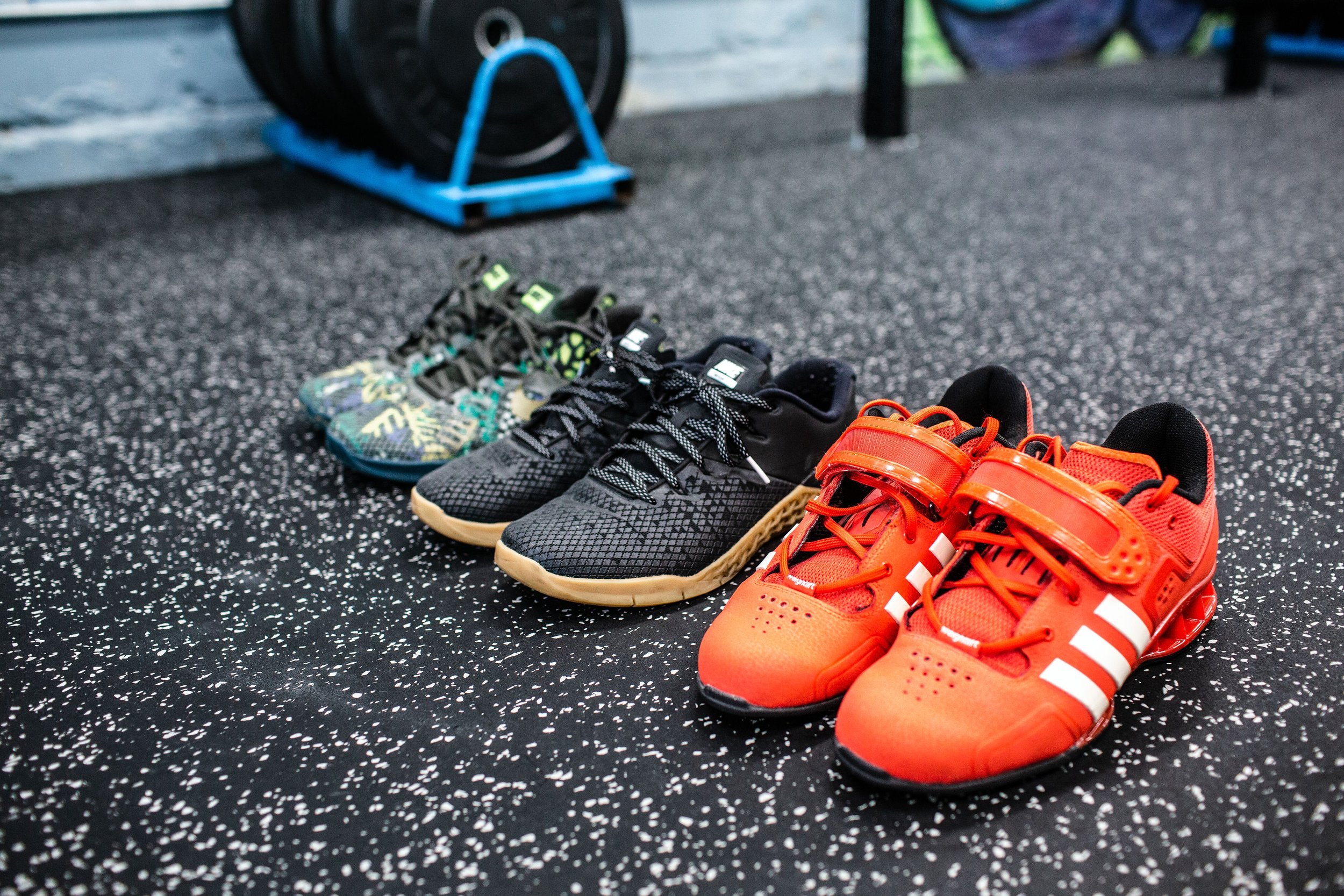What Kind Of Shoes Are Best For The Gym?
Believe it or not, footwear plays a big role in your workouts. Unfortunately, the vast majority of people we see at the gym are wearing shoes that suck for working out!
However, we don’t blame them. There’s been lots of research and progress in the shoe department in recent years, it just hasn’t reached the mainstream quite yet. It’s especially frustrating when you walk into a shoe section and see “Casual, Running, Training” sections. You’re led to believe that all shoes in the training section are good for the gym but that’s not the case.
We’re going to keep this blog post short and sweet.
Bad Gym Shoes
Running Shoes - This is the number 1 shoe that we see people show up to the gym wearing. It’s a shame because they’re usually nice shoes! They’re just not good for the gym!
This is because running shoes have a shape and contour to them that’s meant to help assist someone who’s running in a straight line for long periods of time. Usually a up turned toe that’s off the ground while standing normally and an extra big cushiony heel. Unfortunately, once you start loading any sort of weight on them, the instability is evident. Even a light load on a set of squats, deadlifts and especially single leg exercises (they require more stability) can cause your foot to wobble and you won’t be able to push as much as you’re capable of. If you watch someone try to squat wearing running shoes you’ll notice that they have a hard time getting their whole foot from heel to toe onto the ground.
This can be potentially dangerous. Rolled ankles can lead to muscle tears or other connective tissue injuries. Not only does it increase the risk of injury, but it also decreases the amount of load you can handle on your muscles thus decreasing the effectiveness of your workout. Your feet need to be able to spread wide and grip the ground from all angles in order to produce the strongest contractions.
Good Gym Shoes
A good gym shoe on the other hand has a flat, stable surface and outsole. This will be better at more evenly distributing your weight from your foot through the shoe and into the ground.
Flat Soled Shoes - These include Shoes that have a zero drop or minimal heel to toe drop off. Some examples include:
Converse
Vans
Nike Metcons
Reebok Nano (Crossfit) Shoes
Tennis Shoes
No Bull
Underarmour Tribase
Great Gym Shoes
New Balance Minimus
Vivobarefoot
TYR Barefoot Shoes
INOV-8 Bare Shoes
Bearfoot Ursus
Other Barefoot Shoes!
The list is not limited to only those shoes. The list of great barefoot style gym shoes grows stronger every year. These shoes great for a few reasons:
They’re designed to be gym shoes that have minimal or zero drop so you have a stable base of support to press off of. (Similar to the “good gym shoes”)
They have a wide toe box to fit your toes comfortably and let them spread naturally under load.
so they tend to have at least 2 elements over the Converse and Vans. The first is that they’re designed to be a more breathable workout shoe. The second is that they’re made to help stabilize your feet while doing forward, backwards and lateral movements. The converse and vans on the other hand are still good flat soled shoes, but they lack the workout design advantages that the other shoes have.
The Argument For Barefoot Training (Can be in socks too, same same)
Barefoot Training has become increasingly more popular. There are a few main benefits to training barefoot:
Your foot is not relying on the shoe to provide support. This means you’ll be strengthening your foot muscles and muscles around your ankle joint while working out. This not only has strength benefits, but it can also help decrease risk on injuries. So many running and foot injuries are related to weak foot muscles (even leg muscles such as glutes, calves and tibialis anterior). Simply training barefoot can help strengthen those muscles and decrease the likelihood of an injury! Some common injuries include shin splits and side (lateral) or front (anterior) knee pain.
Your feet and toes are meant to spread and grip the ground. When you wear a shoe with a narrow toe box (which is most shoes unfortunately) , your toes gets slightly squished and you actually can’t spread your toes. This in turn can lead to poor gate (walking form) and possibly lead to injury as well.
Your feet are just like your hands in the sense that they’re very sensory based. Training barefoot will enhance the proprioception of your feet which again
The only real downside to training barefoot is that of course you’re more susceptible to accidental injuries. For example in the gym, you hit your foot on a piece of equipment, or stub your toe, you might accidentally drop a weight on your foot, etc. This can really hurt and possibly cause an injury if this happens to you. At least wearing a flat soled shoe will damped the blow and mitigate some of the potential for a foot injury.
Weight Lifting Shoes
There is another category of gym shoes that are specifically for Olympic weight lifting. We only recommend these shoes if you are participating in Olympic weightlifting, or if you prefer using an elevated heel for performing squats. Otherwise, these shoes are not ideal for a general purpose gym or athletic shoe.
Some great examples of these shoes include:
Nike Nike Men's Romaleus Training Shoes
Adidas Adipower
TYR L-1 Lifter
Reebok Legacy Lifter

